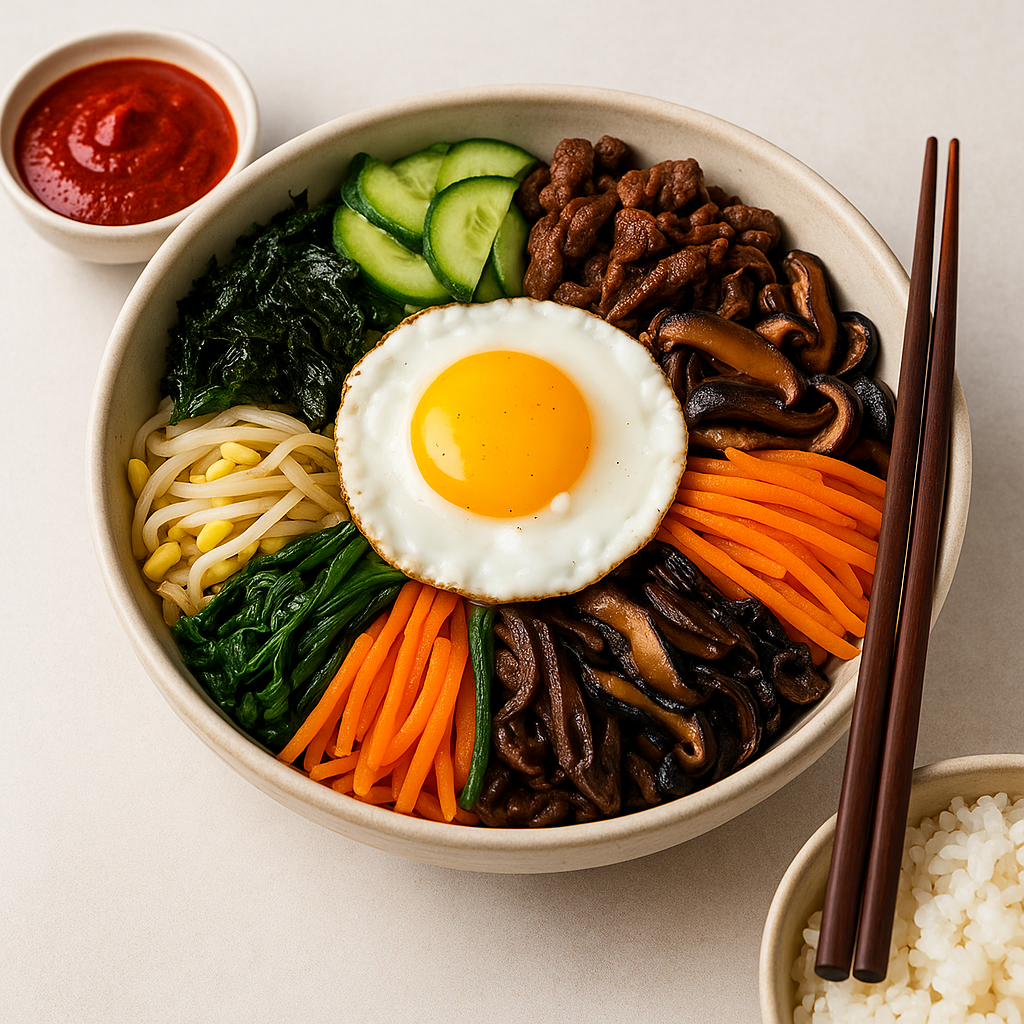🥗 Korean Soul Food Series #4: Bibimbap – The Art of Harmony in a Bowl
Bibimbap isn’t just a meal—it’s a philosophy. A bowl of Korean mixed rice that harmonizes flavors, colors, nutrients, and even emotions. It represents Korea’s deep respect for balance and beauty, and it’s no wonder this dish is one of the most popular Korean foods around the world.
Whether served in a hot stone bowl (dolsot) or in a simple ceramic dish, the magic of bibimbap lies in its contrast—crunchy vs soft, spicy vs mild, hot vs cool. And when mixed just right? It becomes a comforting, nutritious, and utterly satisfying experience.
🌈 A Symphony of Color and Texture
Each ingredient in bibimbap plays a visual and nutritional role:
- 🟢 Spinach, zucchini – rich in iron & chlorophyll
- 🟠 Carrots, bell pepper – loaded with beta-carotene
- ⚪ Bean sprouts, mushrooms – crunchy, earthy base
- 🔴 Kimchi or chili paste (gochujang) – fermented flavor burst
- 🟡 Egg – usually sunny-side up, crowning glory
It’s a natural multivitamin in a bowl—no wonder it’s a healthy Korean dish favored by wellness lovers.
🍳 Tips for the Perfect Bibimbap
- 💧 Use freshly steamed short-grain rice for better stickiness.
- 🥢 Mix your bowl with chopsticks first, not a spoon—it helps blend the textures more delicately.
- 🔥 Add a drizzle of sesame oil or perilla oil at the end for aroma and flavor lift.
- 🧂 Adjust gochujang with a splash of soy sauce or sugar depending on your spice tolerance.
🛒 Ingredients You Need
Don’t worry—you don’t need 20 side dishes to start. A basic bibimbap ingredients list includes:
- Cooked white rice (or brown rice for a twist)
- Assorted sautéed vegetables (spinach, carrot, bean sprouts)
- Gochujang (Korean chili paste)
- Fried egg or raw yolk
- Optional: bulgogi beef, tofu, mushrooms, kimchi
🍲 What to Serve with Bibimbap?
To complete the experience, pair your bibimbap with:
- 🫕 Doenjang-guk (soybean paste soup)
- 🥟 Kimchi pancakes (kimchijeon)
- 🥬 Simple seaweed salad or pickled radish
- 🍵 Roasted barley tea or plum juice
📌 FAQ
Q: Is bibimbap good for weight loss?
Yes! It’s a balanced meal high in fiber, protein, and nutrients—especially with brown rice and vegetables.
Q: Can I make vegan bibimbap?
Absolutely. Use tofu, mushrooms, and plenty of veggies. No egg or meat needed.
Q: What if I can’t find gochujang?
Use sriracha mixed with miso paste or Korean soy sauce.
🎯 Final Scoop
Bibimbap is a bowl of color, balance, health, and harmony. It’s more than a recipe—it’s the story of Korean food culture, designed for nourishment and joy.
🌍 Loved the harmony of Bibimbap?
Discover more iconic Korean soul food that touches your heart and taste buds.
From sizzling dumplings to crispy Hotteok—your next favorite might be just one bite away!
🍴 Explore More Korean Dishes
